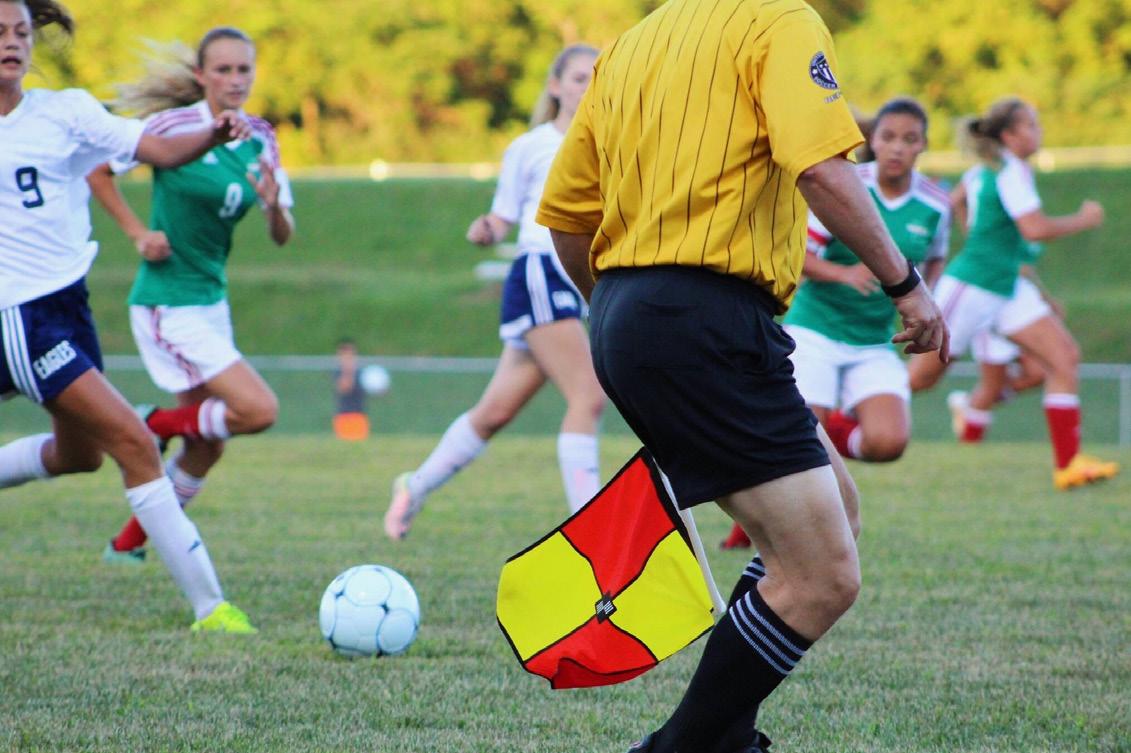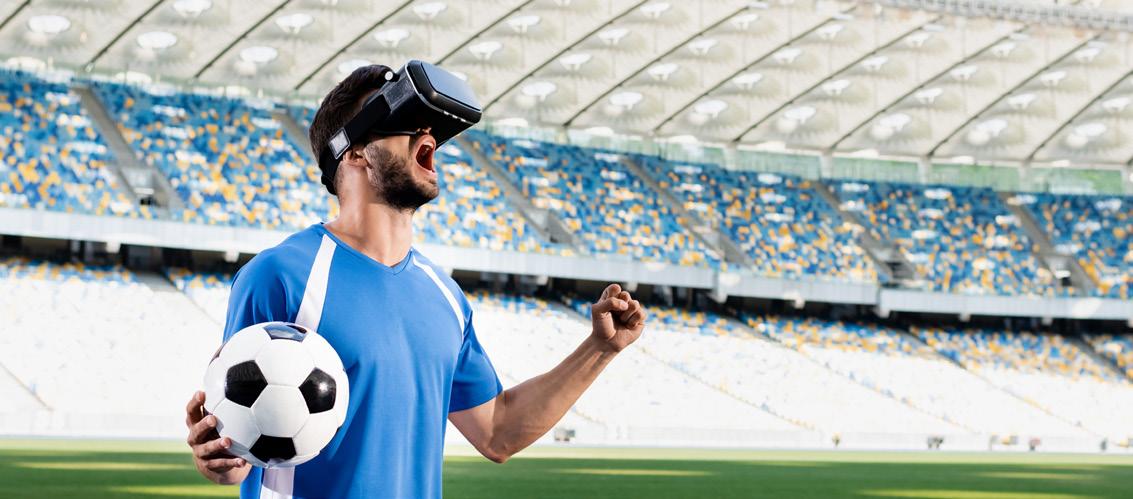
24 minute read
Sports Innovation In The Industry From A Startup Perspective
By Carsten Couchouron & René Engelhardt Hansen
Advertisement
Sportstech innovation typologies review
This section presents the insights gained from our pursuit to explore Sportstech innovation in the industry from a startup perspective. As innovation in the industry is a broad area, we chose to focus on startups as they can be perceived to be the main drivers of Sportstech innovation. We start off by exploring current typologies used in the global industry to develop an operational and industry-aligned framework to categorize Sportstech. Subsequently, the framework is utilized to identify, categorize, and map current Danish startups as well as comparing the findings to international trends. Finally, we combine the insights gained to identify gaps and potential opportunities for future Sportstech innovation in Denmark.
We set out to research if there were any existing Sportstech innovation typologies that could be used for the football industry, and that could help us gain a better understanding of the sector, the current areas of innovation, the scoping of our project, and the use of a common terminology. Our search process was based on desktop research as well as on our industry knowledge and international network. The latter materialized through conversations with industry peers and attendance of sports and football tech conferences. Our research revealed that various organizations have defined certain categories for the purpose of mapping out Sportstech companies operating in specific Sportstech eco-systems that they are working with. These categories form the basis of classification systems that were developed by consultancies, investment firms, Sportstech hubs, publishers, academic scholars etc. to suit their specific needs and perspectives. While most of these approaches are of a general nature, some take a deeper dive into a specific sector (e.g. football), or take the perspective of a particular end-user (e.g. stadiums, athletes). The general comparison of the various Sportstech classifications found through our desk research is represented in Appendix B. From the mapping and comparison (see Appendix B), we can identify the following overall categories:
• Social & Fan engagement • Facilities & Events • Media & Sponsorship • Performance, Training & Health • Data & Analytics • E-sports • AR & VR
These general categories are useful for determining a general Sportstech categorization system which can be used for all sports, and therefore also for football. However, the categories identified above cannot be used as a definite categorization structure for two reasons.
The first reason is that this categorization does not distinguish between the ends and the means, as “Data & Analytics” can be used for “Performance, Training & Health”, and “AR & VR” can be used for “Social & Fan Engagement” or “Media & Sponsorship”, for example. Therefore, “Augmented & Virtual Reality (AR & VR)” and “Data & Analytics”, which are technology types, are to be considered as means, while the remaining categories “Social & Fan Engagement”, “Facilities & Events”, “Media & Sponsorship” and “Performance, Training & Health” are to be considered as aims.
The second reason is that, notwithstanding the debate on whether e-sports is a sport, e-sports should be considered as a certain type of activity and not as a type of sports technology. Hence all Sportstech categories identified can apply to e-sports the same way that they apply to football or handball etc.
Hence, based on our review of existing typologies and identification of common categories, we propose a general Sportstech categorization as represented in figure 9 below. While we have found one specific approach focused on football performance (see Appendix B), it failed to satisfy our quest for an all-encompassing typology as it lacks certain sub-categories and seems to focus on certain specific technologies. That said, from our research and industry discussions, we could not see any reasons why football should have a specific categorization system that is different from other sports.
Social & Fan Engagement Facilities & Events Media & Sponsorship
Figure 9. General Sportstech categories based on a review of existing typologies Performance, Training & Health
Sportstech typology developed by SportsTechX
Our desktop research and industry insights revealed that the most widely accepted and used typology currently is the one developed by SportsTechX, a Berlin-based boutique consultancy that specializes in global Sportstech intelligence and publishes regular reports on the sports tech industry.2 Adopting a systematic and holistic approach, the SportsTechX typology, which the authors call the Sportstech Framework, has become the current industry reference when it comes to an all-encompassing Sportstech typology. This typology was developed in recent years and has been regularly enhanced and updated as the sector developed and as SportsTechX’s global database of Sportstech companies grew. Startups, companies, and organizations are classified into three main sectors depending on their target audience: the Athlete (Activity & Performance), the Fan (Fans & Content), and the Sports Executive (Management & Organization), and then into a second and third level of classification.
The SportsTechX typology is shown in Figure 10 and compared with other existing typologies in appendix B. It is also noteworthy that SportsTechX, who issued a special report focused on football tech in November 2020, have used their general typology for the purpose of mapping out the global football tech industry.
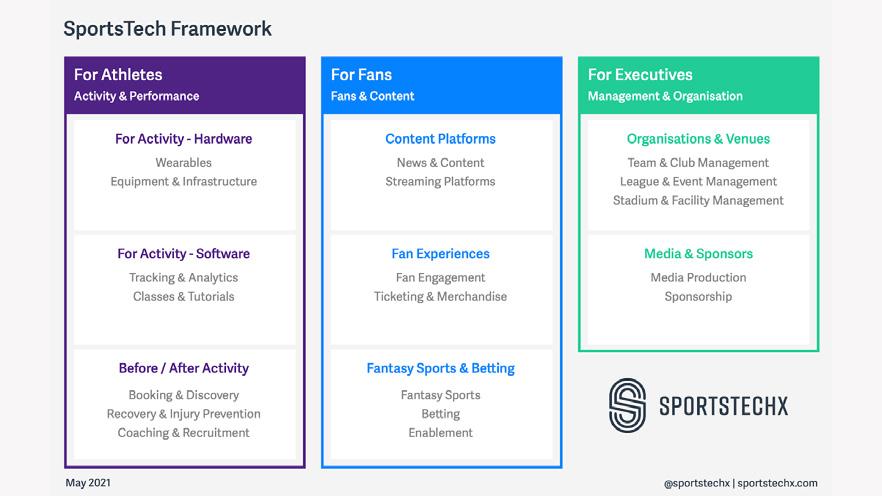
Figure 10. Sportstech typology developed by SportsTechX: Sportstech Framework (Penkert & Malhotra, 2021)
As shown in Figure 11 below, the 1st level categories from the SportsTechX typology are almost identical to the general Sportstech categories resulting from our review of existing typologies. The only real difference between the two is that our general Sportstech categories make a further distinction between technology targeted towards Facilities & Events executives, and technology aimed at Media & Sponsorship executives. Given the specificities and extent of each of these two areas, we however believe that keeping this distinction makes sense for our general Sportstech categories.
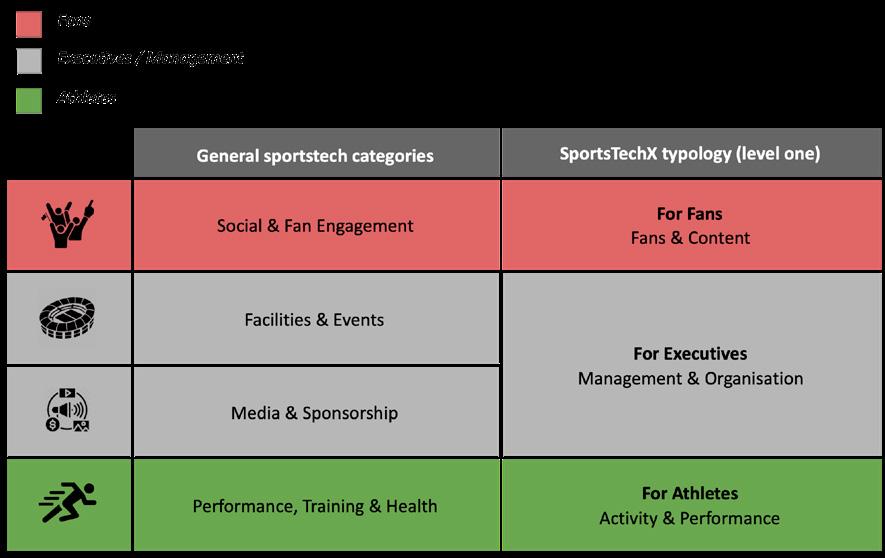
Figure 11. Comparison of general Sportstech categories from research on existing typologies and SportsTechX typology. Colours indicate the target users: Fans (red), Executives / Management (grey) and Athletes (green).
Sportstech typology developed by Sascha L. Schmidt
While the SportsTechX typology focuses on the target audience, or end-user, another typology, with an approach which focuses on the type of technology used, was developed by Sascha L. Schmidt. His typology relies on three main types of technologies, which he defines as:
• Advanced materials, sensors, devices, inter-
net of things, and biotech. This technology category is mostly about physical technologies (e.g. hardware). It includes technologies such as robotics, sensors, fibres, textiles, coatings, composites, etc. Many of these technologies play a key role in capturing data.
• Data, artificial intelligence, and machine
learning. This technology category is concerned with data handling and processing.
It includes technologies in the realm of big data, advanced analytics, artificial intelligence, machine learning, etc.
• Information, communication, and extended
reality. This technology category is about human interaction. It plays a particularly significant role in Sportstech (e.g. fan engagement) with technologies such as AR/VR/MR, voice, or mobile technologies in general. Figure 12 shows examples of technologies falling under each of these three technology categories.

Figure 12. Tech angle categories and example technologies (Schmidt, 2020)
Sascha L. Schmidt goes one step further and combines his technology types with the SportsTechX Framework into a 2-dimensional matrix, which he calls the Sportstech Matrix (Schmidt, 2020). The matrix in Figure 13 captures how distinct types of technologies provide solutions to different user groups in the realm of sports. One dimension, which shows the user-angle, is represented by the three main user groups defined by SportsTechX: Athletes, Consumers, Management (note: this has been replaced by Athletes, Fans and Executives in the updated 2021 SportsTechX Framework). The other dimension shows the tech angle, based on the author’s technology taxonomy suitable for capturing Sportstech, which he has developed. We found this combination to be fruitful for pursuing our goal of developing an all-encompassing typology.
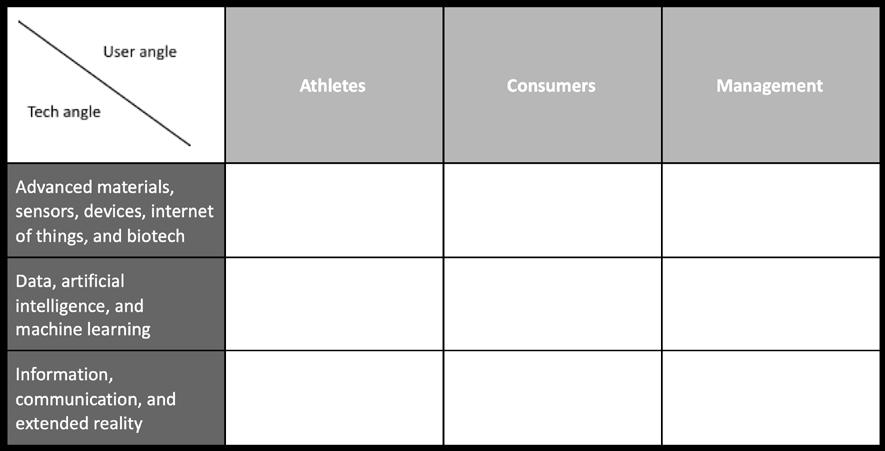
Figure 13. Sascha Schmidt’s Sportstech Matrix - a 3x3 grid along the user angle and the tech angle, providing an all-encompassing structure for a mutual understanding for the field of Sportstech (Schmidt, 2020).
Photo by pexels-pixabay
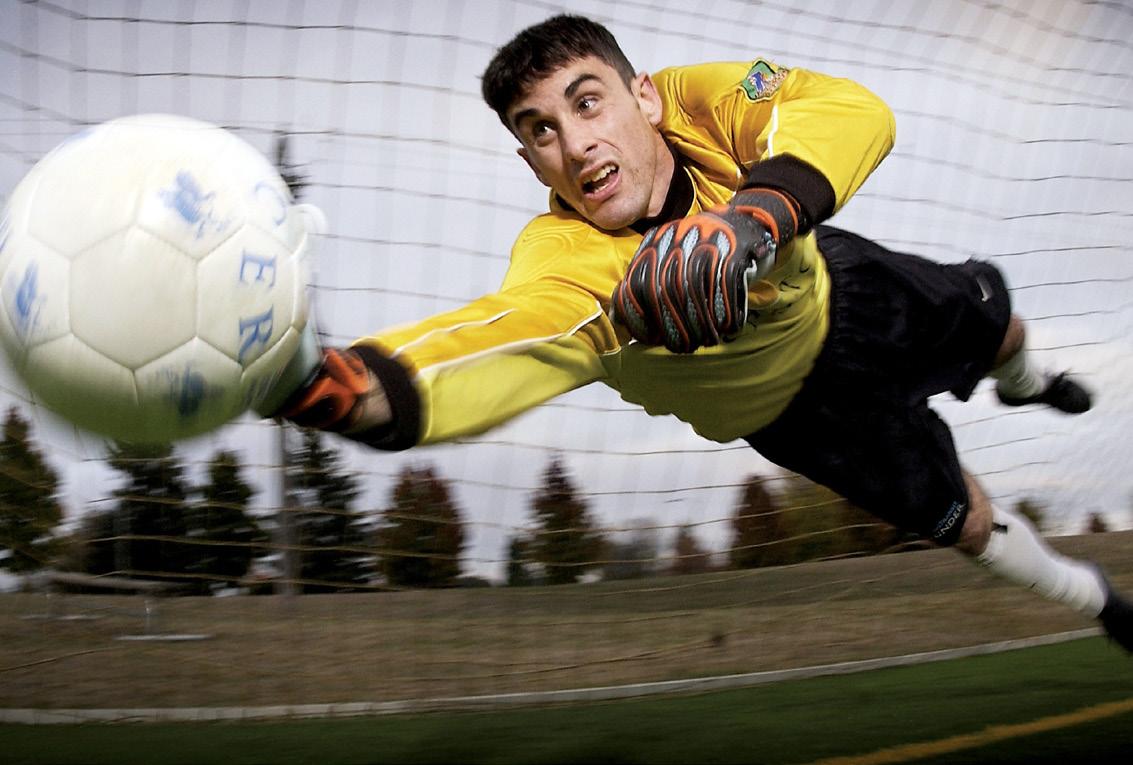
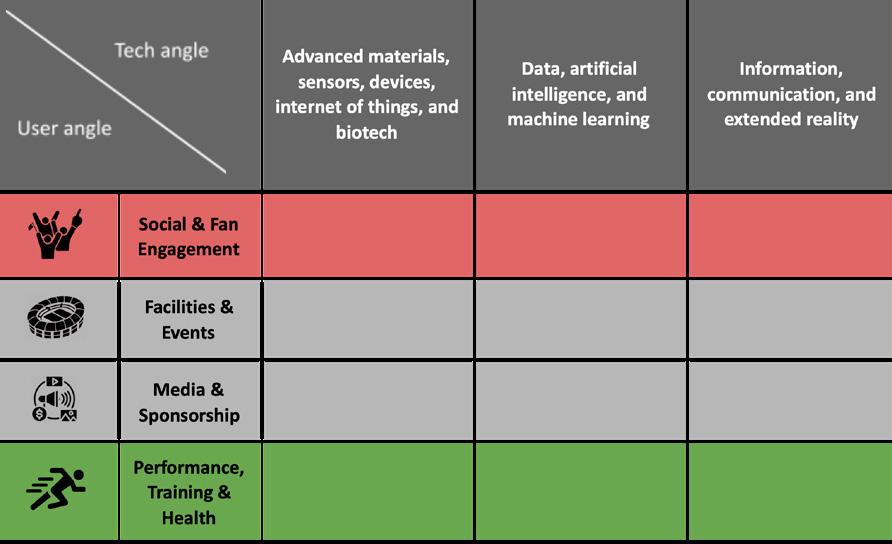
Figure 14. Our proposed General Sportstech Matrix (applicable to Football) – based on a 3x4 grid along the user angle and the tech angle, providing an all-encompassing structure for a mutual understanding for the field of sports tech. Colours indicate the target users: Fans (red), Executives / Management (grey) and Athletes (green).
Conclusions on general existing typologies
As we set out to review existing Sportstech typologies to better understand the sector, find a common language and scope our work, our research revealed that existing typologies developed by various organizations to meet their specific needs are mixing up technology types, technology uses and user groups. By mapping and grouping the various categories used in the existing typologies, we were however able to propose a general categorization based on technology purpose: Social & Fan Engagement, Facilities & Events, Media & Sponsorship, Performance, Training & Health. The SportsTechX Framework, which has been updated in 2021, is the most recognized typology to date and proposes that Sportstech be classified into three main categories based on targeted users. It mainly differs from our proposed general categorization in that it combines the “Facilities & Events” and “Media & Sponsorship” categories into one category called “For Executives”. The 2-dimensional matrix from Sascha Schmidt, which combines the tech angle and the user angle, is the most all-encompassing structure for understanding the Sportstech sector. It combines the three technology groups that he has identified with the three user groups from the SportstechX Framework.
Based on the above, we found it fruitful for pursuing our goal of developing an all-encompassing categorization to use the Sascha Schmidt matrix but replacing the SportstechX categories with our general categorization (in essence, this means adding the distinction between Facilities & Events and Media & Sponsorship in the user dimension).
We therefore propose to use a General Sportstech Matrix as shown in Figure 14 as an all-encompassing typology, which can also be applied to football tech.
It must, however, be noted that while such a general matrix provides a well-encompassing structure, many startups/products/services operate across categories, and it can be hard to fit them in a specific box or category. They can cut across different user groups and/or tech categories. In fact, this cross-category approach is often at the very core of innovative solutions. With this limitation in mind, we nevertheless believe that the proposed General Sportstech Matrix is a useful tool for our understanding of the Sportstech innovation sector and for developing a common language and terminology with stakeholders of the future football innovation centre.
It will also allow us to map the Danish football tech sector to identify current as well as unserved or under-served innovation areas where potential future innovation could take place.

With the framework for general categorization of Sportstech products and services presented in the previous section, we turn the focus to the identification of current and future innovation areas in the football Sportstech industry. Our research presented in this section focused on identifying, categorizing, and mapping startups that have a clear focus on football. These could be companies that are football-specific or that are multi-sports oriented, but where football is one of the clear focus areas. As startups, we consider recently set-up companies that are building new and innovative products or solutions from the ground-up. The startups that we found are at various stages in their development, from early prototyping to product maturity, from very early stage to well-established and scaling internationally. This research work was based on a combination of industry knowledge and a review of general Sportstech databases and reports. Using our proposed general Sportstech categorization and adding a secondary category to reflect the types of solutions that Danish startups are currently offering, we were able to develop a typology of Denmark-based football tech startups. By mapping existing Danish football tech startups within that typology, we identified current areas of innovation in Denmark.
Finally, we mapped Danish startups with the international football tech innovation landscape, as per the 2021 Football Tech Report from SportsTechX (Penkert & Malhotra, 2021), to compare the Danish focus areas with international trends, and to identify potential opportunities for future innovation in Denmark.
Identification and mapping of current football tech startups showing areas of focus in Denmark
In order to get a better understanding of the current Danish sports tech sector in football, we have as a first step undertaken to identify existing startups based in Denmark and/or operating in Denmark. Identification of such startups has been done by a combination of industry knowledge from experts working with Sportstech in Denmark, and a review of existing international Sportstech startup databases and reports. These were registered in an online Airtable database, where various parameters were entered, including the SportstechX Framework categories and the categories from our general Sportstech categorization. Using the data pertaining to the Denmark-based startups that are in our database, we have as a second step defined a purpose-based categorization of Denmark-based Football Tech startups. This categorization consists of main categories, which correspond to our Sportstech general categorization identified during our review of existing Sportstech typologies, and secondary categories which were identified through an abductive process by reviewing the products and services of Denmark-based football tech startups. In Figure 15 below, we have represented the current map of startups in Denmark operating in football tech. Such a map highlights the innovation areas of focus in Denmark by showing the number and type of startups operating in each of the main and secondary categories. We have chosen in this analysis to only place companies in one category. Some startups may overlap to some of the other categories. We have chosen the main category in these cases.
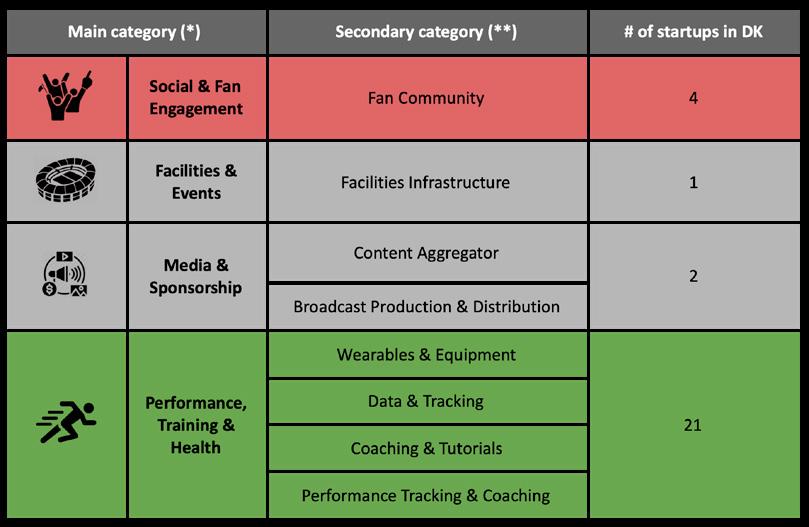
Figure 15. Denmark-based football tech startups categorization – mapping according to an abductive process (*) From the General Sports Tech Matrix (Figure 11.) (**) From a database of Denmark-based football tech startups (abductive process)
Figure 16. Danish Football Tech – Startup map (status as of August 2021)
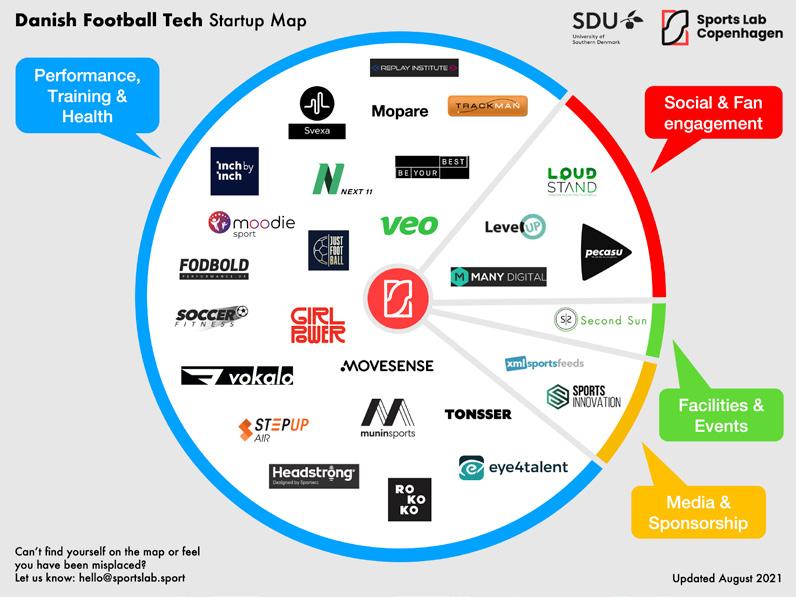
Mapping of Danish football tech startups against general Sportstech typology and international trends – gaps and potential future areas of innovation
As we now have an overview of Denmark-based football tech startups, we set-out to compare the proportion of Danish startups with the proportion of global startups within each of the three main categories from the SportstechX typology, to identify areas of strength in Denmark and potential gaps which could form areas of future innovation focus.
Number of startups in football tech per SportstechX typology
As illustrated in Figure 17, at a global level, almost half (46.5%) of the football tech startups operate in the Fans & Content category, while almost one third (30.9%) operate in the Activity & Performance category and 22.5% operate in the Management & Organization category. In comparison, and as illustrated in Figure 18, if we look at our database of Denmark-based football tech startups, 75% operate in the Activity & Performance category, while 10% operate in Management & Organization and 15% in Fans & Content. It must, however, be noted here that our review of Danish football tech did not include startups operating in the betting sector, and that could account for part of the difference in the Fans & Content category.
Number of Startups in FootballTech per Sector
Figure 17. Number of startups in football tech per category at a global level (Penkert & Malhotra, 2020)
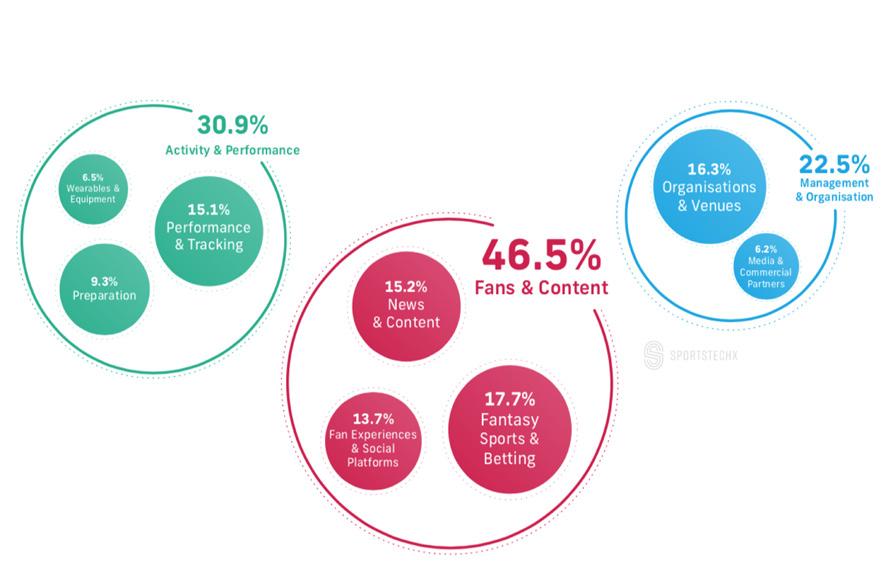
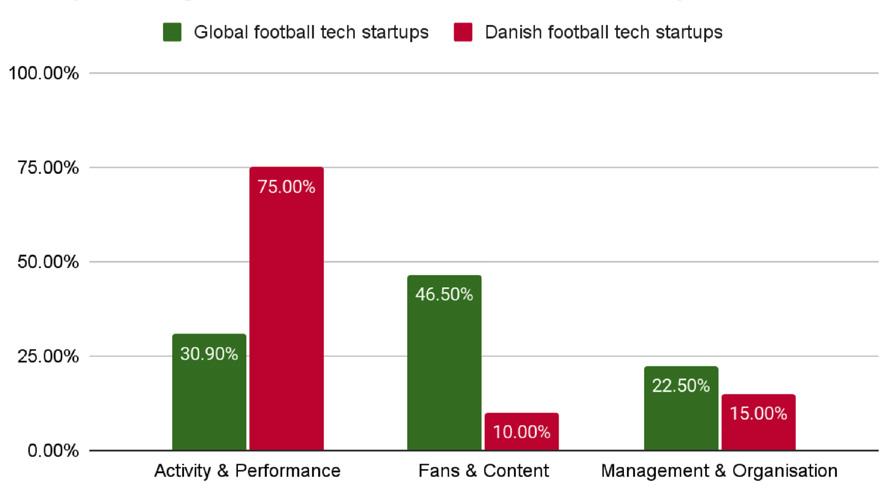
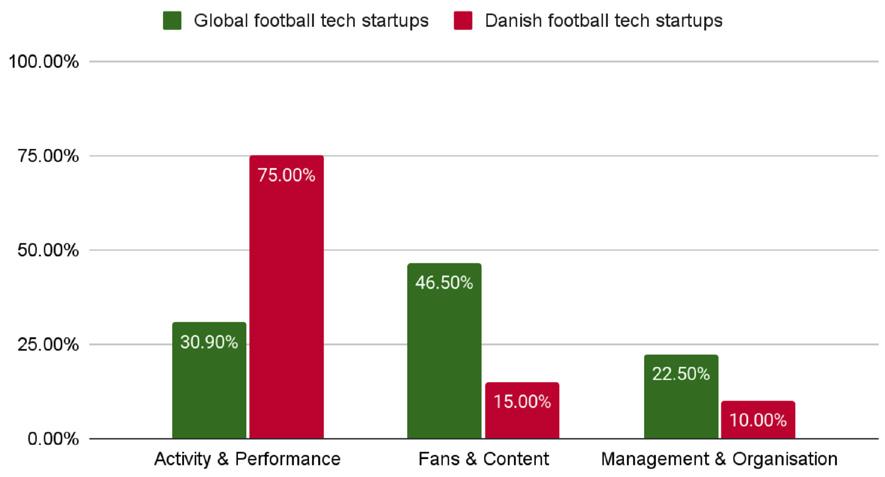
Figure 18. Number of startups in football tech per category - Global vs Denmark comparison. Sources: Penkert & Malhotra, 2021 and our review of Denmark-based football tech startups
From this comparison, we conclude that the industry-driven football tech innovation in Denmark is not following the global trend. Denmark is highly active in the Activity & Performance category. Conversely, the Fans & Content and the Management & Organization categories are under served. It is especially noteworthy with respect to the Fans & Content category, as this is the most important category globally in terms of number of startups. While we have not researched the reasons for this discrepancy, one could be that Denmark has a tradition of focusing on solutions to increase physical activity within the population and to enhance the performance of its elite athletes. Denmark does not have a strong research tradition into sports management but is known worldwide for doing performance and health research. SDU and UCPH are, according to the Shanghai ranking, among the top 10 sports sciences departments in the world. On the other hand, solutions to drive fan engagement and media content have traditionally been a focus area of larger countries and global capitals that have strong media ecosystems. Fans & Content, and to a lesser extent Management & Organization, are therefore two categories where more innovation could take place in Denmark in the future.
As a next step, and to dive a bit deeper into our Denmark vs. Global comparison, we compared the two geographical regions at the second and third levels of the SportstechX typology (see the SportstechX typology in Figure 10). Most of the areas in the Activity & Performance category, where the end-user is the Athlete, are covered by Denmark-based startups. Only one out of the seven sub-categories, Booking & Discovery, is not covered. This is also logical as the vast majority of startups from a Danish perspective are operating within Activity & Performance. It is important to also note that the Booking & Discovery category is also well represented in Denmark by startups that do not have a specific focus on football and are therefore not included in this report.
However, only 5 out of 7 sub-categories are covered in the Fans & Content category, where the end-user is the Fan, as our study did not reveal any Denmark-based football tech startups in the Streaming Platforms and Ticketing & Merchandising sub-categories. The Betting and Enablement (tools to aid the sports betting industry, bettors, or fantasy sports gamers) sub-categories were not included in the scope of our study: However, Denmark boasts several startups in the sports betting industry. Finally, only 3 out of 5 sub-categories are covered in the Management & Organization category, where executives are the end-user, as our study did not reveal any Denmark-based football tech startups in the League & Event management, and Sponsorship sub-categories.
Photo by Alexander Nadrilyanski from Pexels

Top 10 countries and cities in football tech by number of startups
Finally, it is interesting to note that, according to SportstechX, Denmark is very well positioned on the global map of football tech. Indeed, Denmark is in the top 10 countries and Copenhagen in the top 10 cities in the number of startups in football tech (Figure 19). According to our review of the Danish football tech startup landscape, as of August 2021, there are approximately 28 startups in Denmark with a strong focus on football.


Figure 19. Top 10 countries and cities in football tech by number of startups (globally) (Penkert & Malhotra, 2020)
Mapping in practice
Our research in this report led us to identify Denmark-based startups that are operating in football tech. We have recorded these startups in an innovative and user-friendly spreadsheet-like database called Airtable (www.airtable.com). The advantages of Airtable include easy entering and visualization of data, including files and visual representations, a collaboration interface, and a multitude of apps allowing us to use, link and visualize the data in various ways. We found Airtable to be a suitable tool for creating our dynamic and multi-dimensional matrix, as it is powerful and evolutive, as well as adapted to collaborative use. Our Airtable database of Denmark-based football tech startups captures various dimensions of relevance to the football sector depending on stakeholder interest(s). We have called it the FootballTech Multiform Matrix. It includes the SportstechX typology and the Sascha Schmidt technology types, which are useful for aligning with industry language and standards. It also includes our categorization of Denmark-based football tech startups developed in this report, as well as several dimensions/parameters (see Figure 15). This database of Denmark-based football tech startups enabled us to look at startups and the solutions that they propose from different angles, and to filter and group them according to the different dimensions.
Such an approach gives a much more dynamic view of the startup scene and allows us to look at multidimensional typologies as well as to perform certain specific analyses. An example of this can be found in the Sportstech report from consultants Roland Berger, where startups are analysed in a matrix with mono-sport, multi-sport on one axis and amateur, pro, fan on the other axis. Some examples generated from the Airtable database are provided below. The multi-dimensional Airtable approach also provides the benefit of being able to allocate startups to multiple categories from the same typology. This is particularly useful since, as we have seen, startups often cut across both user and tech categories, thereby providing a more realistic overview and accurate typology.

Example 1: Number of startups per Category (user angle) per Targeted Athlete Level
Example 2: Number of startups per Tech Type per Targeted Athlete Level
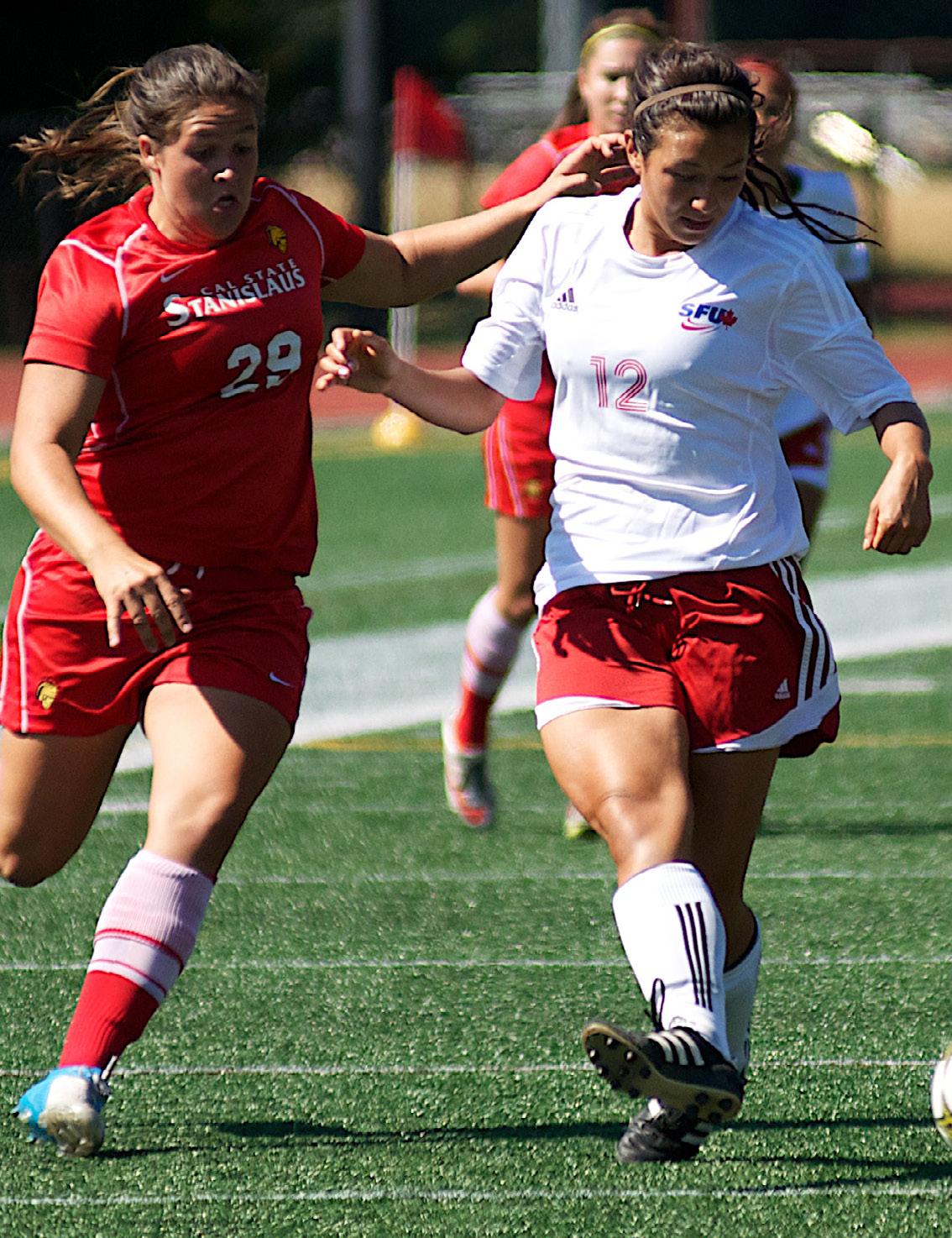
Conclusions, limitations, and further opportunities for Sportstech innovation in football from a startup perspective
While we are confident that our review has identified most of the relevant football tech startups in Denmark, it is a very dynamic field and startups are constantly created, while others disappear. We have included in our database all startups identified, which are based in Denmark, and are focused on football, or have football as one of their main sports of focus if they are multisports. However, there are a multitude of startups that are operating across sports and/or categories that fall outside the sports sector (tourism, urbanization, IT etc.), which are also relevant for football. These have not been considered in this report, as we cannot cover everything. Similarly, we have not included startups in e-sports and betting, as we have considered these to be part of industries and eco-systems of their own. By allowing the mapping of the Danish football tech landscape according to multiple dimensions relating to the various categorizations identified in this report, and according to other attributes that are relevant in the analysis of startups, the FootballTech Multiform Matrix provides a much more accurate typology and powerful tool for stakeholders and overcomes the shortcomings of the two-dimensional typologies currently in use in the industry. It also accounts for the cross-category nature of most startups by allowing them to be categorized across multiple categories of the same typology. Based on the typologies and categorizations used, it can provide stakeholders with a common language, as well as a common tool to perform various analyses. The collaborative capabilities of the Airtable application allow sharing and interactive uses of the database to account for the dynamic aspect of the football tech sector. It is hoped that it can facilitate matchmaking amongst stakeholder groups and provide greater opportunities for industry-academic collaborations. While the matchmaking can be somewhat automated through analysis, the human factor/judgement should not be underestimated.
Another expected benefit of the FootballTech Multiform Matrix is that it can help with the identification of areas of innovation where few startups are currently operating, by analysing the Danish startup ecosystem according to certain dimensions. This could help uncover areas for future innovation.
As a database, it is only as good as the data that entered. Keeping such a database up to date is critical. This can become a laborious task given the very fast evolving nature of the football tech industry. To ease this process, one option that could be investigated is partnering with other databases or taking a subscription to global databases such as the one curated by SportstechX. However, these databases are also subject to the same limitations linked to the changing landscape and often lack completeness and accuracy on a local geographic level, as the operators of such databases do not have the same detailed level of knowledge and the overview of the Danish startups that we have through our daily work with the local market. Another option could be to have startups validate and update the entries relating to their product/ service solution. The disadvantage of that, however, is the risk that the database loses coherence, as each startup might interpret the dimensions and database attributes somehow differently. One way to further the relevance and capabilities of the FootballTech Multiform Matrix would be to add relevant startups on a Nordic level and beyond. While including all football tech innovation startups on a global scale is probably not possible, including those that are of particular interest and/ or relevance for the industry could be an interesting enhancement of the tool. We should also not underestimate the importance of having our own database, as data ownership becomes increasingly critical and a sensitive matter. For this reason, we recommend not giving public access to the database, but making it available through collaboration projects that the football innovation centre will be able to facilitate.
Our review presented in this publication was based on a combination of desktop research and insights from industry experts. It enabled us to get a better understanding of the current status of Sportstech and football tech innovation in the industry from a startup perspective, and to develop a common language through the identification of a general Sportstech categorization applicable to football tech.
We found it useful to combine this categorization, which takes the user perspective, with a categorization of technology used by the products and services of Sportstech startups, to create an allencompassing 2-dimensional general Sportstech Matrix (Figure 14). While being aware that many startups operate across or innovate at the intersection of some of the categories, and it can therefore be difficult to place them within a certain category, we believe that this common terminology will be useful for future work and for collaborative interactions within the football innovation centre.
Our research revealed that 28 Denmark-based startups currently in operation have football as a main or strong focus. Through an abductive process we were able to identify eight secondary categories pertaining to the type of solution proposed by a given startup. Combined with the main user-category from our General Sportstech Matrix, this provided us with a categorization of Denmark-based football tech startups. Mapping the Danish football tech startups against the global football tech startup landscape proposed by SportstechX revealed that the large majority of football startups in Denmark operate in the Activity & Performance category (75% of startups). Fans & Content and Media & Sponsorship, to a lesser extent, Management & Organization are potential future areas of innovation since these categories are under-represented by Danish startups when compared to the current global trend. While Denmark could benefit from more collaboration across stakeholders, it is already very well positioned when it comes to football innovation, whether it is through the current research and academic-industry partnerships taking place within the University of Southern Denmark, the use of technology and innovative approaches taken by certain football clubs, at both elite and grassroot levels (FC Midtjylland, FC Nordsjælland, FC Copenhagen, FC Brøndby and Skjold Boldklub to name a few), the innovation projects that have been initiated by the league and the federation, and last but not least, the innovative drive coming from startups and from the emerging football innovation cluster pioneered by Sports Lab Copenhagen and the University of Southern Denmark. This new approach is being acknowledged in the SportstechX Football Tech 2020 report in its innovation lab section: “The innovation lab section brings up initiatives by both clubs and associations and with the new football innovation centre run by a collaboration of the Danish Football Federation, the Danish League, Odense Municipality, and Syddansk University also an academic front-runner”. Denmark is on the world map of football tech innovation as illustrated in Figure 20.
Photo by Martí Pardo from Pexels
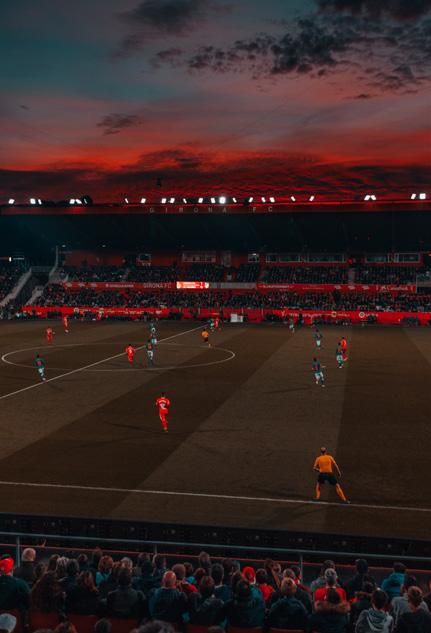

Figure 20. Football innovation hubs globally as per the SportstechX Football Tech Report 2020 (Penkert & Malhotra, 2020)
Photo by Noelle Otto from Pexels
